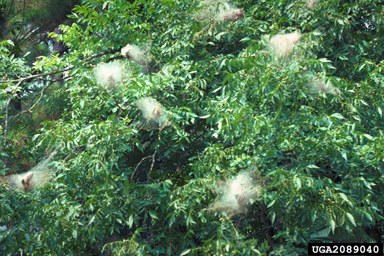Posted: November 3, 2022
Many questions arise about the unsightly webs hanging off of deciduous trees. Learn more about the fall webworm.

Photo by Lacy Hyche, bugwood.org
Those ugly web masses decorating our trees may seem threatening, but they are harmless. When fall webworms (Hyphantria cunea) hatch, they become white moths that lay their eggs on the undersides of leaves or at the end of branches of deciduous trees. Since they hatch in the fall, they do not eat the tender spring leaves. As they eat the leaves they spin a web which contains the worms, leaf litter, and debris. Webworms, although unsightly, rarely kill trees. The worms or caterpillars are an important source of food for migrating birds, such as orioles, tanagers, and vireos. After feeding, caterpillars will overwinter in cocoons in the leaf litter under a tree. Cleaning leaf litter under trees may limit infestation the following year, but otherwise, no management is recommended.
More information about this insect can be found on the Penn State Extension Factsheet called "Fall Webworms"

